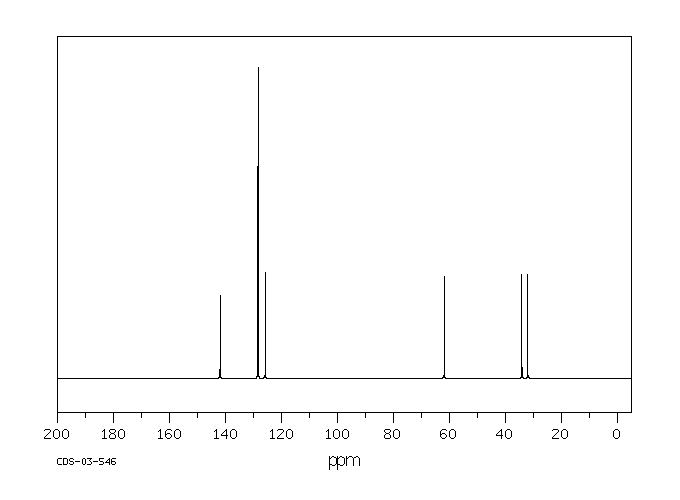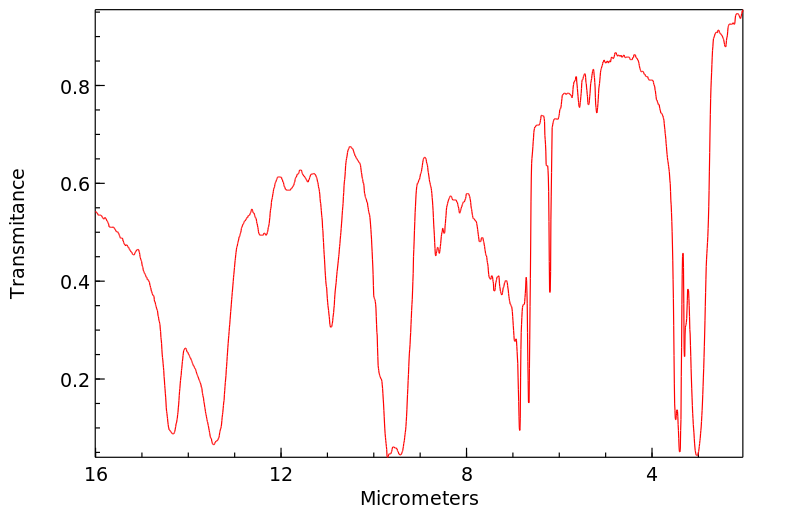3-苯丙醇 | 122-97-4
-
物化性质
-
计算性质
-
ADMET
-
安全信息
-
SDS
-
制备方法与用途
-
上下游信息
-
文献信息
-
表征谱图
-
同类化合物
-
相关功能分类
-
相关结构分类
物化性质
-
熔点:−18 °C(lit.)
-
沸点:119-121 °C12 mm Hg(lit.)
-
密度:1.001 g/mL at 20 °C(lit.)
-
闪点:229 °F
-
溶解度:水中的溶解度0.1g/l
-
LogP:1.6-2.06 at 35℃
-
物理描述:Liquid
-
颜色/状态:Colorless liquid
-
气味:Floral odor
-
味道:Sweet and pungent taste suggestive of apricot
-
蒸汽压力:0.0234 mm Hg at 25 °C (extrapolated from higher temperatures)
-
亨利常数:2.03e-07 atm-m3/mole
-
稳定性/保质期:
Stable under recommended storage conditions.
-
汽化热:Enthalpy of vaporization: 62.6-62.8 kJ/mol
-
折光率:Index of refraction: 1.5357 at 25 °C
-
解离常数:pKa = 15.96 at 25 °C (est)
-
保留指数:1261;1205;1200;1203;1203;1197;1218;1201;1202;1202;1202;1200
计算性质
-
辛醇/水分配系数(LogP):1.9
-
重原子数:10
-
可旋转键数:3
-
环数:1.0
-
sp3杂化的碳原子比例:0.333
-
拓扑面积:20.2
-
氢给体数:1
-
氢受体数:1
ADMET
安全信息
-
TSCA:Yes
-
危险品标志:Xi
-
安全说明:S26,S37/39
-
危险类别码:R36/38
-
WGK Germany:1
-
海关编码:29062900
-
危险品运输编号:NONH for all modes of transport
-
RTECS号:UB8970000
-
包装等级:I; II; III
-
危险性防范说明:P261,P305+P351+P338
-
危险性描述:H315,H319,H335
SDS
制备方法与用途
3-苯丙醇用于合成二氢肉桂基西尼地平的试剂,是一种有效的芳香生物转化产物。它还被广泛应用于香料和药物的合成,并且在医药工业中是中枢骨骼肌松弛剂强盘松的中间体。
化学性质3-苯丙醇为无色粘稠液体,具有甜花香气和甜蜜饯香味,稀释后有清新的瓜果香。沸点236℃,闪点109℃。它溶于乙醇、丙二醇和大多数非挥发性油中,不溶于甘油和矿物油,极微溶于水(1:300)。天然品存在于草莓、苏合香膏、安息香膏、茶叶、秘鲁香膏、桂叶油等中。
用途GB 2760-1996规定为暂时允许使用的食用香料。主要用以配制桃、杏、李、西瓜、梅、草莓和核桃、榛子等坚果型香精,适用于胆囊炎、胆管炎、胆石症、胆道术后综合症及高胆固醇血症等疾病的治疗。
3-苯丙醇还用于合成香料和医药品,在医药工业中是中枢骨骼肌松弛剂强筋松的中间体。该物质具有甜花香气和蜜饯香味,稀释后有清新的瓜果香。天然品存在于草莓、菌合香膏、安息香膏、茶叶、桂叶油等中,我国 GB2760-86规定为暂时允许使用的食用香料。
含量分析按总醇量测定法(OT-5)测定,所取试样量为1g。计算中的当量因子(f)取68.10。或按气相色谱法(GT-10-4)中用非极性柱方法测定。
毒性GRAS(FEMA)。LD₅₀2300mg/kg(大鼠,经口)。
使用限量FEMA(mg/kg):软饮料0.73;冷饮1.4;糖果2.8;焙烤食品3.3;胶姆糖4.3;酒类5.0。适度为限(FDA§172.515,2000)。
食品添加剂最大允许使用量与最大允许残留量标准添加剂中文名称:苯丙醇
允许使用该种添加剂的食品中文名称:食品
添加剂功能:食品用香料
最大允许使用量(g/kg):用于配制香精的各香料成分不得超过在GB 2760中的最大允许使用量和最大允许残留量
3-苯丙醇由肉桂酸乙酯催化加氢制得。加氢反应在高压釜中进行,采用铬-铜-钡催化剂,温度为200℃,氢压约20MPa。加氢反应5-9小时后,冷却滤去催化剂,滤液用乙醚提取。提取液回收乙醚后进行减压蒸馏,收集110-112℃(1.06kPa)馏分,即为成品,收率约85%。
上下游信息
-
上游原料
中文名称 英文名称 CAS号 化学式 分子量 (3-甲氧基丙基)苯 3-methoxypropylbenzene 2046-33-5 C10H14O 150.221 3-苯基丙基过氧化氢 3-phenylpropyl hydroperoxide 60956-33-4 C9H12O2 152.193 正丙基苯 Propylbenzene 103-65-1 C9H12 120.194 3-苯基丙基甲酸盐 3-phenylpropyl formate 104-64-3 C10H12O2 164.204 氢化肉桂基亚硝酸酯 nitrous acid-(3-phenyl-propyl ester) 28537-55-5 C9H11NO2 165.192 3-苯基丙酸 3-Phenylpropionic acid 501-52-0 C9H10O2 150.177 —— (3-(methoxymethoxy)propyl)benzene 91898-11-2 C11H16O2 180.247 [3-(烯丙基氧基)丙基]苯 3-phenylpropyl alcohol allyl ether 93981-51-2 C12H16O 176.258 1-碘-3-苯基丙烷 1-iodo-3-phenylpropan 4119-41-9 C9H11I 246.091 苯丙醛 3-phenyl-propionaldehyde 104-53-0 C9H10O 134.178 1-溴-3-苯基丙烷 1-Bromo-3-phenylpropane 637-59-2 C9H11Br 199.09 1-氯-3-苯基丙烷 phenylpropyl chloride 104-52-9 C9H11Cl 154.639 4-苯基-1-丁烯 3-butenylbenzene 768-56-9 C10H12 132.205 1-(3-苯基丙基)-1-(1,1-二甲基乙基)醚 1-(3-phenylpropyl)-1-(1,1-dimethylethyl) ether 199275-18-8 C13H20O 192.301 D-苯丙氨醇 (R)-2-amino-3-phenylpropanol 5267-64-1 C9H13NO 151.208 乙酸-3-苯基丙酯 3-phenylpropyl acetate 122-72-5 C11H14O2 178.231 3-(4-甲苯)丙酸 3-(4-Methylphenyl)propanoic acid 1505-50-6 C10H12O2 164.204 —— 3-(Propan-2-yloxymethoxy)propylbenzene 91898-13-4 C13H20O2 208.301 (3-((2-甲氧基乙氧基)甲氧基)丙基)苯 3-(2-Methoxyethoxymethoxy)propylbenzene 87770-91-0 C13H20O3 224.3 —— 3-pentynyl 3-phenylpropyl ether —— C14H18O 202.296 —— 3-phenylpropyl chloroformate 65935-40-2 C10H11ClO2 198.649 —— 3-tert-butylperoxypropyl benzene 419568-76-6 C13H20O2 208.301 —— (Z)-4-(3-phenylpropoxy)-but-2-en-1-ol 1141498-22-7 C13H18O2 206.285 3-苯基-1-丙基三甲基甲硅烷基醚 trimethyl(3-phenylpropoxy)silane 14629-60-8 C12H20OSi 208.376 3-苯丙酸甲酯 3-phenylpropanoic acid methyl ester 103-25-3 C10H12O2 164.204 —— 3-(2,2,2-Trifluoroethoxy)propylbenzene 80054-73-5 C11H13F3O 218.219 —— 1-[3-(3-methylbut-3-enyloxy)propyl]benzene 1141498-00-1 C14H20O 204.312 (NE)-N-(3-苯基亚丙基)羟胺 3-phenylpropanal oxime 1197-50-8 C9H11NO 149.192 乙基苯 ethylbenzene 100-41-4 C8H10 106.167 (2,3-环氧丙基)苯 (2,3-Epoxypropyl)benzene 4436-24-2 C9H10O 134.178 环丙基苯 cyclopropylbenzene 873-49-4 C9H10 118.178 1-苯基-1,3-丙二醇 1-phenyl-1,3-propanediol 4850-49-1 C9H12O2 152.193 4-苯基丁酸 4-Phenylbutyric acid 1821-12-1 C10H12O2 164.204 3-苯丙酸乙酯 ethyl dihydrocinnamate 2021-28-5 C11H14O2 178.231 —— 3-phenylpropanoyl fluoride 458-69-5 C9H9FO 152.168 3-苯基丙基硼酸 3-phenylpropylboronic acid 36329-85-8 C9H13BO2 164.012 异丁酸-3-苯基丙酯 3-phenylpropyl 2-methylpropanoate 103-58-2 C13H18O2 206.285 3-苯基丙醇甲磺酸盐 3-phenylpropanol methanesulfonate 69804-99-5 C10H14O3S 214.285 —— 1-benzyloxy-3-phenylpropane 70770-06-8 C16H18O 226.318 3-(4-溴苯基)丙酸 3-(4-bromophenyl)propionic acid 1643-30-7 C9H9BrO2 229.073 3-苯基丙酰胺 3-phenylpropionamide 102-93-2 C9H11NO 149.192 3-苯丙酰氯 hydrocinnamic acid chloride 645-45-4 C9H9ClO 168.623 3-苯基丙基 3-苯基丙酸酯 3-phenylpropionic acid 3-phenylpropyl ester 60045-27-4 C18H20O2 268.356 (3-苯丙基)三氯硅烷 (3-Phenylpropyl)trichlorsilan 13617-40-8 C9H11Cl3Si 253.631 —— 1-methylethyl 3-phenylpropionoate 22767-95-9 C12H16O2 192.258 —— 3-phenyl-1-propyl 2,2-dimethylpropanoate 87228-44-2 C14H20O2 220.312 —— 3-phenyl-1-(trimethylsilyl)-1-propanol 112947-62-3 C12H20OSi 208.376 烯丙基3-苯基丙酸酯 allyl 3-phenylpropionate 15814-45-6 C12H14O2 190.242 乙基溴苯 1-phenyl-2-bromoethane 103-63-9 C8H9Br 185.063 —— 1-methyl-4-[(3-phenylpropoxy)methyl]benzene —— C17H20O 240.345 —— Dichloroacetic acid, 3-phenylpropyl ester 87228-47-5 C11H12Cl2O2 247.121 二苄基甲酮 1,3-Diphenylacetone 102-04-5 C15H14O 210.276 3-苯-1-丙炔 propargyl benzene 10147-11-2 C9H8 116.163 —— 3-phenyl-propionic acid butyl ester 20627-49-0 C13H18O2 206.285 —— 2-methoxyethyl 3-phenylpropanoate 28049-08-3 C12H16O3 208.257 4-苯基丁烷过氧乙酸 peracide phenyl-4 butanoique 62103-17-7 C10H12O3 180.203 L-苯丙氨酸 L-phenylalanine 63-91-2 C9H11NO2 165.192 烯丙苯 allylbenzene 300-57-2 C9H10 118.178 2-碘代乙基苯 2-phenethyl iodide 17376-04-4 C8H9I 232.064 三乙基(3-苯基丙氧基)硅烷 3-phenylpropanol triethylsilyl ether 2290-40-6 C15H26OSi 250.456 1-苯基-3-丁烯-1-醇 1-Phenyl-3-buten-1-ol 80735-94-0 C10H12O 148.205 —— tert-butyl 3-phenylpropylcarbonate —— C14H20O3 236.311 苯丙酸,4-氯-,甲酯 methyl 3-(4-chlorophenyl)propanoate 50561-69-8 C10H11ClO2 198.649 —— 2-(3-phenylpropoxy)tetrahydrofuran —— C13H18O2 206.285 —— peracide phenyl-5 pentanoique 85696-63-5 C11H14O3 194.23 3-苯基丙酸叔丁酯 tert-butyl 3-phenylpropanoate 16537-10-3 C13H18O2 206.285 2-苯基氧杂环丁烷 2-phenyloxetane 4436-23-1 C9H10O 134.178 - 1
- 2
- 3
- 4
- 5
- 6
- 7
-
下游产品
中文名称 英文名称 CAS号 化学式 分子量 (3-甲氧基丙基)苯 3-methoxypropylbenzene 2046-33-5 C10H14O 150.221 —— O-(3-phenyl-propyl)-hydroxylamine 94115-39-6 C9H13NO 151.208 3-苯基丙基过氧化氢 3-phenylpropyl hydroperoxide 60956-33-4 C9H12O2 152.193 正丙基苯 Propylbenzene 103-65-1 C9H12 120.194 (3-乙氧基丙基)苯 hydrocinnamyl ethyl ether 5848-56-6 C11H16O 164.247 2-甲基-3-苯丙醇 2-methyl-3-phenylpropanol 7384-80-7 C10H14O 150.221 3-苯基丙基甲酸盐 3-phenylpropyl formate 104-64-3 C10H12O2 164.204 —— bis(3-phenylpropyl) ether 72666-87-6 C18H22O 254.372 (3-(乙烯氧基)丙基)苯 (3-(vinyloxy)propyl)benzene 71532-17-7 C11H14O 162.232 —— 1-chloromethyl 3-phenylpropyl ether 90875-79-9 C10H13ClO 184.666 氢化肉桂基亚硝酸酯 nitrous acid-(3-phenyl-propyl ester) 28537-55-5 C9H11NO2 165.192 —— 2-(3-phenylpropoxy)ethanol 119967-39-4 C11H16O2 180.247 3-苯基丙酸 3-Phenylpropionic acid 501-52-0 C9H10O2 150.177 —— (3-(methoxymethoxy)propyl)benzene 91898-11-2 C11H16O2 180.247 —— 3-(3-phenylpropoxy)propan-1-ol —— C12H18O2 194.274 —— (3-butoxypropyl)benzene 76382-80-4 C13H20O 192.301 [3-(烯丙基氧基)丙基]苯 3-phenylpropyl alcohol allyl ether 93981-51-2 C12H16O 176.258 (3-苯基丙氧基)乙醛 (3-phenyl-propoxy)-acetaldehyde 84930-13-2 C11H14O2 178.231 —— (3-fluoropropyl)benzene 2038-62-2 C9H11F 138.185 —— (3-isobutoxypropyl)benzene 53119-45-2 C13H20O 192.301 苯代丙腈 dihydrocinnamonitrile 645-59-0 C9H9N 131.177 —— methylthiomethyl 3-phenylpropyl ether 153163-69-0 C11H16OS 196.313 —— (3-(difluoromethoxy)propyl)benzene 1577210-89-9 C10H12F2O 186.201 1-碘-3-苯基丙烷 1-iodo-3-phenylpropan 4119-41-9 C9H11I 246.091 —— 1-(3-phenylpropyl)-1-pentyl ether —— C14H22O 206.328 苯丙醛 3-phenyl-propionaldehyde 104-53-0 C9H10O 134.178 1-溴-3-苯基丙烷 1-Bromo-3-phenylpropane 637-59-2 C9H11Br 199.09 1-氯-3-苯基丙烷 phenylpropyl chloride 104-52-9 C9H11Cl 154.639 1,3-二苯丙烷 1,3-diphenylpropane 1081-75-0 C15H16 196.292 3-苯基-1-丙胺 3-Phenylpropan-1-amine 2038-57-5 C9H13N 135.209 3-苯基-1-丙烷硫醇 3-Phenylpropane-1-thiol 24734-68-7 C9H12S 152.26 1-(3-苯基丙基)-1-(1,1-二甲基乙基)醚 1-(3-phenylpropyl)-1-(1,1-dimethylethyl) ether 199275-18-8 C13H20O 192.301 —— (propyl-3-d)-benzene 117657-84-8 C9H12 121.186 —— 2-[2-[2-[2-(3-Phenylpropoxy)ethoxy]ethoxy]ethoxy]ethanol 180965-49-5 C17H28O5 312.406 1,1-二甲氧基-3-苯基丙烷 (3,3-dimethoxypropyl)benzene 30076-98-3 C11H16O2 180.247 4-氨基苯丙醇 3-(4-aminophenyl)propan-1-ol 14572-92-0 C9H13NO 151.208 乙酸-3-苯基丙酯 3-phenylpropyl acetate 122-72-5 C11H14O2 178.231 —— 1,5-diphenylpentan-3-ol 17486-86-1 C17H20O 240.345 4-溴苯丙醇 3-(4-bromophenyl)propanol 25574-11-2 C9H11BrO 215.09 苯戊醇 5-phenylpentan-1-ol 10521-91-2 C11H16O 164.247 —— 4-(3-Phenylpropoxy)but-2-yn-1-ol 1132648-09-9 C13H16O2 204.269 3-(4-碘苯基)-1-丙醇 3-(4-iodophenyl)-1-propanol 60075-78-7 C9H11IO 262.09 —— (3-(trifluoromethoxy)propyl)benzene 149054-29-5 C10H11F3O 204.192 —— 3-(4-Methoxybut-2-ynoxy)propylbenzene 1132648-06-6 C14H18O2 218.296 (3-((2-甲氧基乙氧基)甲氧基)丙基)苯 3-(2-Methoxyethoxymethoxy)propylbenzene 87770-91-0 C13H20O3 224.3 —— 3-phenylpropyl chloroformate 65935-40-2 C10H11ClO2 198.649 —— 3-tert-butylperoxypropyl benzene 419568-76-6 C13H20O2 208.301 —— 5-phenylpent-1-yn-3-ol —— C11H12O 160.216 —— 5-phenylpent-1-en-3-ol 37904-38-4 C11H14O 162.232 —— heptyl-(3-phenyl-propyl)-ether 110966-15-9 C16H26O 234.382 —— (Z)-4-(3-phenylpropoxy)-but-2-en-1-ol 1141498-22-7 C13H18O2 206.285 3-苯基-1-丙基三甲基甲硅烷基醚 trimethyl(3-phenylpropoxy)silane 14629-60-8 C12H20OSi 208.376 苯丙氨酯 phenprobamate 673-31-4 C10H13NO2 179.219 —— 1,5-diphenylpentane 1718-50-9 C17H20 224.346 1-苯基己烷-3-醇 1-phenylhexan-3-ol 2180-43-0 C12H18O 178.274 5-苯基-1-戊炔 5-phenyl-1-pentyne 1823-14-9 C11H12 144.216 3-苯丙酸甲酯 3-phenylpropanoic acid methyl ester 103-25-3 C10H12O2 164.204 —— 3-phenylpropyl methanesulfinate 393781-86-7 C10H14O2S 198.286 盐酸氟西汀B methyl-(3-phenyl-propyl)-amine 23580-89-4 C10H15N 149.236 4-苯基丁腈 4-phenylbutyronitrile 2046-18-6 C10H11N 145.204 —— 2-(3-phenylpropoxy)acetic acid 627895-44-7 C11H14O3 194.23 —— 2-benzyl-3-phenylpropan-1-ol 21991-31-1 C16H18O 226.318 3-苯基异氰酸丙酯 (3-isocyanopropyl)benzene 111944-21-9 C10H11N 145.204 6-苯基己基苯 1,6-diphenylhexane 1087-49-6 C18H22 238.373 —— 3-(2,2,2-Trifluoroethoxy)propylbenzene 80054-73-5 C11H13F3O 218.219 —— 4-(3-phenylpropoxy)butan-2-one —— C13H18O2 206.285 —— 3-(3-phenylpropoxy)propanoic acid 393569-04-5 C12H16O3 208.257 (2-溴丙基)苯 (2-bromopropyl)-benzene 2114-39-8 C9H11Br 199.09 (NE)-N-(3-苯基亚丙基)羟胺 3-phenylpropanal oxime 1197-50-8 C9H11NO 149.192 —— 3-phenylpropanal oxime 1197-50-8 C9H11NO 149.192 —— (E)-3-phenylpropanal oxime —— C9H11NO 149.192 乙基苯 ethylbenzene 100-41-4 C8H10 106.167 —— (E)-5-phenyl-2-penten-1-ol 75553-23-0 C11H14O 162.232 苯丙醇丙酸盐 propionic acid-(3-phenyl-propyl ester) 122-74-7 C12H16O2 192.258 庚基苯 heptylbenzene 1078-71-3 C13H20 176.302 —— methyl 3-phenylpropyl carbonate —— C11H14O3 194.23 —— 1-phenylhex-5-yn-3-ol 36185-09-8 C12H14O 174.243 —— (3-((6-bromohexyl)oxy)propyl)benzene 94749-20-9 C15H23BrO 299.251 —— phosphorous acid tris-(3-phenyl-propyl ester) —— C27H33O3P 436.531 —— hex-5-yn-1-ylbenzene 100848-88-2 C12H14 158.243 正壬基苯 n-nonylbenzene 1081-77-2 C15H24 204.356 —— (S)-1-phenyl-5-hexen-3-ol —— C12H16O 176.258 1-苯基-5-己烯-3-醇 1-phenylhex-5-en-3-ol 60340-28-5 C12H16O 176.258 [3-(叔戊氧基)丙基]苯 [3-(tert-pentyloxy)propyl]benzene 1030853-39-4 C14H22O 206.328 1-丁基-3-苯基-1-丙醇 1-phenylheptan-3-ol 19969-03-0 C13H20O 192.301 N-乙基-3-苯基-1-丙胺 N-ethyl-3-phenylpropylamine 13125-62-7 C11H17N 163.263 6-苯基-1-己烯 6-phenyl-1-hexene 1588-44-9 C12H16 160.259 苯戊醛 5-phenyl-1-pentanal 36884-28-3 C11H14O 162.232 5-苯基戊腈 5-phenylvaleronitrile 7726-45-6 C11H13N 159.231 N,N-二甲基-3-苯基丙烷-1-胺 N,N-dimethyl-3-phenylpropylamine 1199-99-1 C11H17N 163.263 3-苯基丙基碳酸乙酯 ethyl (3-phenylpropyl) carbonate 6324-79-4 C12H16O3 208.257 —— bis(3-phenylpropyl) carbonate 102162-49-2 C19H22O3 298.382 2-[(3-苯基丙氧基)甲基]环氧乙烷 2-<(3-phenylpropoxy)methyl>oxirane 80910-19-6 C12H16O2 192.258 —— γ-Phenyl-propyl-monophosphat 86977-01-7 C9H13O4P 216.174 —— 4-<4-(3-Hydroxypropyl)phenyl>butyric acid 180133-74-8 C13H18O3 222.284 —— ethyl 3-phenylpropyl sulfide 132150-34-6 C11H16S 180.314 Β-甲基苯戊醇 2-methyl-5-phenylpentan-1-ol 25634-93-9 C12H18O 178.274 —— (3-chlorobutyl)benzene 4830-94-8 C10H13Cl 168.666 —— (4-methylpent-3-en-1-yl)benzene 33501-90-5 C12H16 160.259 - 1
- 2
- 3
- 4
- 5
- 6
- 7
- 8
- 9
- 10
反应信息
-
作为反应物:描述:参考文献:名称:醇的轻度有机催化脱氢全合成多烯天然产物二氢干蛋白摘要:多烯合成:描述了一种多烯天然产物二氢木鲁林(1)的全合成的有效方法。已经开发了一种新颖的,温和的,直接的由有机醇IBX介导的简单醇脱氢制氢成烯醛的方法,这是合成中的关键步骤(参见方案)。DOI:10.1002/chem.201103325
-
作为产物:参考文献:名称:多组分 Pt 基锯齿形纳米线作为选择性加氢反应的选择性控制器摘要:α, β-不饱和醛的选择性加氢是一项极其重要的转化,而开发对高附加值产品具有理想选择性的高效催化剂具有挑战性,主要是由于两个共轭不饱和官能团的共存。在此,我们报道了一系列 Pt 基锯齿形纳米线 (ZNW) 可用作 α, β-不饱和醛加氢的选择性控制器,其中优异的不饱和醇 (UOL) 选择性 (>95%) 和高饱和醛 ( SA) 选择性 (>94%) 分别在 PtFe ZNWs 和 PtFeNi ZNWs+AlCl3 上实现。PtFe ZNWs 优异的 UOL 选择性归因于表面 Pt 原子的较低电子密度,而 PtFeNi ZNWs+AlCl3 的高 SA 选择性归因于 PtFeNi ZNWs 和 AlCl3 之间的协同作用,DOI:10.1021/jacs.8b03862
-
作为试剂:参考文献:名称:三氟甲烷磺酸作为在用酸酐和混合酸酐酰化醇时极活泼的路易斯酸催化剂。摘要:可商购的三氟甲磺酸(三氟甲磺酸late)是一种实用且有用的路易斯酸催化剂,用于在对硝基苯甲酸酐的存在下将醇与酸酐酰化或将醇通过羧酸酯化。三氟甲磺酸scan的极高的催化活性可用于协助伯醇的酸酐酰化以及空间受阻的仲或叔醇的酸酐酰化。所提出的方法对于ω-羟基羧酸的选择性大内酯化特别有效。DOI:10.1021/jo952237x
文献信息
-
Mild reduction of carboxylic acids to alcohols using cyanuric chloride and sodium borohydride作者:Massimo Falorni、Andrea Porcheddu、Maurizio TaddeiDOI:10.1016/s0040-4039(99)00734-0日期:1999.6Several carboxylic acids, including N-Boc, N-Cbz and N-Fmoc amino acids were reduced to the corresponding alcohols by activation of the carboxy function with cyanuric chloride and N-methylmorpholine followed by reduction with aqueous sodium borohydride.
-
Metal-, Photocatalyst-, and Light-Free Minisci C–H Alkylation of <i>N</i>-Heteroarenes with Oxalates作者:Jianyang Dong、Zhen Wang、Xiaochen Wang、Hongjian Song、Yuxiu Liu、Qingmin WangDOI:10.1021/acs.joc.9b00972日期:2019.6.7for metal-, photocatalyst-, and light-free Minisci C–H alkylation reactions of N-heteroarenes with alkyl oxalates derived from primary, secondary, and tertiary alcohols. The protocol uses environmentally benign persulfate as a stoichiometric oxidant and does not require high temperatures or large excesses of either of the substrates, making the procedure suitable for late-stage C–H alkylation of complex
-
H<sub>5</sub>IO<sub>6</sub>/KI: A New Combination Reagent for Iodination of Aromatic Amines, and Trimethylsilylation of Alcohols and Phenols through<i>in situ</i>Generation of Iodine under Mild Conditions作者:Mohammad Ali Zolfigol、Ardeshir Khazaei、Eskandar Kolvari、Nadiya Koukabi、Hamid Soltani、Maryam BehjuniaDOI:10.1002/hlca.200900259日期:2010.3A simple method for the in situ generation of iodine using H5IO6/KI has been developed, and its application in silylation of OH group and iodination of aromatic amines is described.
-
A Series of Deoxyfluorination Reagents Featuring OCF<sub>2</sub> Functional Groups作者:Shiyu Zhao、Yong Guo、Zhaoben Su、Wei Cao、Chengying Wu、Qing-Yun ChenDOI:10.1021/acs.orglett.0c03238日期:2020.11.6utilization of decomposition products of PFECAs. We report herein a new series of deoxyfluorination reagents featuring OCF2 functional groups derived from certain PFECAs. Alkyl fluorides were generated from various alcohols in ≤97% yield by these novel reagents. The mechanistic experiment verified in situ generation of carbonic difluoride (COF2).
-
Facile Generation of Alkoxy Radicals from <i>N</i>-Alkoxyphthalimides作者:Sunggak Kim、Tai Au Lee、Yukwan SongDOI:10.1055/s-1998-1711日期:1998.5N-Alkoxyphthalimides, stable and readily accessible from alcohols and alkyl halides, are found to be very efficient alkoxy radical precursors.N-烷氧基邻苯二甲酰亚胺,从醇和卤代烷中稳定且易于获得,被发现是非常高效的烷氧基自由基前体。
表征谱图
-
氢谱1HNMR
-
质谱MS
-
碳谱13CNMR
-
红外IR
-
拉曼Raman
-
峰位数据
-
峰位匹配
-
表征信息











